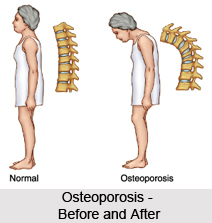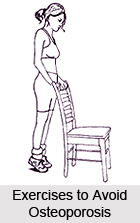 Osteoporosis, commonly known as soft or brittle bones, refers to increased porousness of bones. The word literally means porous or honeycombed bones. In this disorder, the bones of the skeleton become fragile due to excessive loss of bone tissues. It may cause the bones to fracture more easily than they should. If the disease affects the spine, it may lead to collapse of the vertebral bodies and consequent deformity. Often called the `silent killer`, there are no symptoms or warnings of the onset of osteoporosis.
Osteoporosis, commonly known as soft or brittle bones, refers to increased porousness of bones. The word literally means porous or honeycombed bones. In this disorder, the bones of the skeleton become fragile due to excessive loss of bone tissues. It may cause the bones to fracture more easily than they should. If the disease affects the spine, it may lead to collapse of the vertebral bodies and consequent deformity. Often called the `silent killer`, there are no symptoms or warnings of the onset of osteoporosis.
Osteoporosis can occur at any age but it is found more in elderly persons. Bone mass increases rapidly upto adolescence and continues to increase at a reduced rate until the early 30s. In men, bone mass declines steadily from the age of 45 onwards. Individual variation is very wide. The bones commonly affected are wrist bones, spine and hipbones. According to the WHO, one out of three females and one out of eight males in India has this disorder. More women die of osteoporosis fractures than of breast and ovarian cancers. While this disease can strike at any age, it is most commonly found in older women and mostly the factors include age, low body weight, history of fractures, inadequate physical activity, excessive smoking, regular intake of alchohol and menupause.
Causes of Osteoporosis:
The disease is far more prevalent in women than in men, because of calcium loss during pregnancies and menstruation. A broken hipbone is usually considered to be the result of a fall. But in reality, the collapse of the bone is the cause of a fall, which first draws attention to osteoporosis. Osteoporosis occurs, as women get older, since the bones get thinner. It causes a greater risk to break if a person has a minor injury. Medical complications of these injuries can result in longer stays at the hospital, disability, and even death. Other causes of this disease are over consumption of meat, heavy smoking of chronic alcoholism post-menopausal hormonal imbalances and diminished physical activity with age. Prolonged cortisone treatment, by blocking the bone-building activity and decreasing the intestinal absorption of calcium, may also cause osteoporosis.
Surgical removal of the ovaries and intense exercise (such as marathon running) can also reduce estrogen levels. The lower levels of estrogen cause a weakening of the bones. Osteoporosis can also occur as a result of hormone disorders or prolonged bed rest during serious illness. It may appear with osteomalacia, a condition in which the bones soften and weaken from lack of vitamin D. Other possible causes include an imbalance in the body`s natural acidity or a loss of phosphate. Too much aluminum hydroxide, a chemical used to treat ulcers, in the body can also be a cause. Women who smoke or are physically inactive are at a greater risk of developing Osteoporosis. Too little calcium in the diet or a family history of Osteoporosis is also the other risk factors.

Normal bone consists of a series of thin, intersecting plates, called `trabeculae`. A dense shell surrounds these plates. These plates form, what is called the Bone mass. In osteoporosis, they become filled with holes or may even totally disappear. This causes a diminution of bone masses. The shell becomes thin with loss of bone mass. All these changes make the bones extremely fragile and it can crack with the most trivial injury.
Symptoms of Osteoporosis:
Osteoporosis is usually accompanied by severe pain. In elderly patients, the disease is accompanied by an actual loss of height and bending causes a humpback, deformity that crowds lungs and digestive organs. Other symptoms of osteoporosis are backache and spasms of the back muscles, aching of the long bones and, thinning of the pelvic bones, loss in twisting and bending strength and frequent occurrence of spontaneous fractures. Broken bones like the hip, arm, and wrist are common places for breaks. The bones of the spine are also a common area of thinning. Often, over time, the bones of the spine (vertebrae) collapse on themselves, one at a time, causing loss of height, back pain, and changes in posture.
Treatment of Osteoporosis by Nature Cure:
Diet:
Initially, the patient should adopt a raw-juice diet for about five days. In this regimen, he should take juices of fresh fruits and vegetables, diluted with water equally, every two hours during the day. Fruits and vegetables, which can be used for making juices, are oranges, lemons, pineapples, papayas, green leafy vegetables, red beets and carrots. A warm water enema should be taken daily during this period to cleanse the bowels.
After the raw juice diet, the patient may gradually embark upon a well-balanced diet consisting of seeds, nuts, grains, vegetables and fruits. The emphasis should be on mineral-rich foods such as whole grains, seeds, nuts, cooked and raw vegetables, fruits, milk and milk products such as homemade cottage cheese. Foods rich in Calcium, magnesium, potassium and silicon will be especially beneficial in the treatment of this disorder. These foods consist of green vegetables, cabbage, carrots, fruits and berries of all kinds. Strawberries, raspberries, blueberries, sesame seeds and sunflower seeds are excellent foods for use in this disease.
The patient should also take liberal quantities of foods rich in lactic acid, sour milk products, oats, barley, millet and rice. The diet should be supplemented with a good all-inclusive mineral and trace mineral supplement and Betaine Hydrochloride tablets with each meal to ensure proper assimilation. However, the patient should avoid large meals and overeating. He should eat slowly and chew his food extremely well. He should avoid tea, coffee, flesh food, white sugar and white flour products, processed, refined and denatured foods, smoking and alcoholic beverages are completely forbidden.
Exercises:
The patient should undertake regular physical exercise for the prevention and treatment of osteoporosis. Exercises, which put stress on long bones such as walking, jogging and cycling are especially beneficial.




